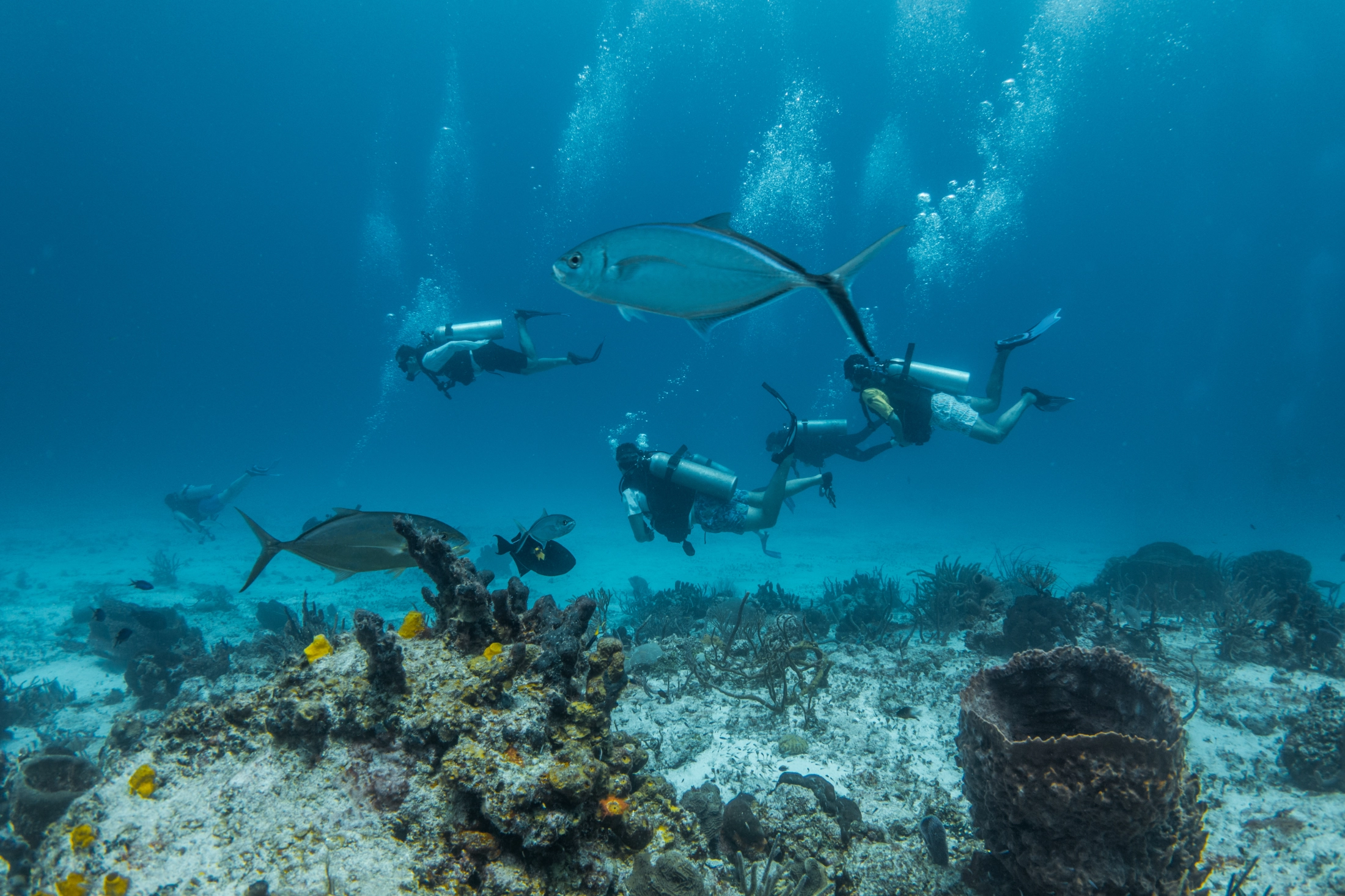Deep Diver
-
Introduction to Deep Diving
-
Preparing for Deep Diving
-
Deep Dive Planning
-
Deep Diving Techniques
-
Equipment for Deep Diving
-
Advanced Buoyancy Control
-
Conservation Awareness for Deep Diving
-
Deep Diver Exam1 Quiz
-
Deep Diver Training Dive 1
-
Deep Diver Training Dive 2
-
Deep Diver Training Dive 3
-
Deep Diver Training Dive 4
By the end of this lesson, you will be able to:
- Explain the reasons to go deep diving
- Understand the risks and safety procedures for deep diving
- Describe deep diving equipment
Welcome to the captivating world of deep diving, where the mysteries of the ocean depths await those who explore beyond the usual shallows. Deep diving, typically defined as diving beyond 18 meters and up to 40 meters within recreational limits, opens up a realm of unique and breathtaking underwater experiences. Here’s why you might consider taking the plunge into deep diving

Reasons to Deep Dive
- Explore Hidden Wonders: Deep diving allows access to dive sites that are beyond the reach of average recreational divers, including historic shipwrecks, deeper coral walls, and unique geological formations
- Challenge and Skill Development: It offers an opportunity to enhance your diving skills, learn advanced techniques, and experience the thrill of exploring deeper waters
- Diverse Marine Life: Many species and ecosystems are unique to deeper waters, offering a chance to witness marine life not found in shallower regions
- Historical and Archaeological Exploration: Many shipwrecks and historical artefacts lie at depths that require deep diving skills, providing a window into history.
Understanding the Risks and Safety Procedures for Deep Diving
Understanding the Risks and Safety Procedures in deep diving is crucial, as it ensures that divers are well-equipped with the knowledge and skills to handle the unique challenges and potential hazards associated with diving at greater depths.
Decompression Sickness (DCS) and Gas Narcosis
Decompression sickness occurs when nitrogen dissolved in the body’s tissues forms bubbles as the diver ascends and pressure decreases. Education on DCS includes recognizing symptoms like joint pain, dizziness, and fatigue and understanding the importance of ascent rate and decompression stops.
Gas narcosis is a condition that affects mental functioning due to the narcotic effect of gases under pressure. Divers are taught to recognize signs like impaired judgment and coordination and how to manage narcosis, such as ascending to shallower depths to alleviate symptoms.
Oxygen Toxicity
At greater depths, the partial pressure of oxygen in breathing gas increases, which can lead to oxygen toxicity. Divers learn about the symptoms, such as visual disturbances and convulsions, and how to prevent them by monitoring exposure time and oxygen levels in their breathing gas
Air Consumption and Management
Deep diving typically involves higher air consumption rates due to increased exertion and higher breathing gas density. Divers are trained in air management techniques, including monitoring air supply closely, planning gas reserves, and understanding how to manage a low-air situation.
Equipment Checks and Maintainance
Proper equipment function is vital in deep diving. Divers should perform thorough pre-dive checks of their gear, including regulators, buoyancy control devices, dive computers, and other safety equipment like signalling devices. Regular maintenance is essential.
Environmental Awareness and Navigation
The underwater environment at depth can be disorienting. It’s important to use techniques for maintaining orientation, natural navigation cues, and compass navigation, as well as understand the impact of limited visibility and water movement at depth.
Physical and Mental Fitness
Deep diving demands good physical and mental fitness. Divers are encouraged to assess their health, fitness levels, and mental preparedness before deep diving. Stress management and maintaining a calm, focused mindset are key aspects of safe deep-diving practices.
Understanding these risks and safety procedures forms the backbone of responsible and safe deep diving. It empowers divers to make informed decisions, handle potential emergencies effectively, and enjoy the deep diving experience while minimizing risks.

Equipment for Deep Diving
Deep diving requires specialized equipment to ensure safety, efficiency, and comfort. We’ll explore the specifics of this gear, highlighting key features that distinguish it from standard diving equipment. Let’s explore these essentials to equip you for your deep diving.
- High-Capacity Tanks and Gas Mixes: Deep dives typically require more gas due to increased consumption at depth. High-capacity tanks can be used. Beyond recreational diving, Tec divers may use specialized gas mixes like Trimix (a blend of oxygen, nitrogen, and helium) to extend bottom time and reduce nitrogen narcosis risk.
- Regulators Rated for Depth: Regulators must be reliable and able to function efficiently under the higher pressure of deep dives. It’s essential to use regulators specifically rated for deep diving and can handle the increased density of gases at depth.
- Dive Computers and Depth Gauges: Dive computers are essential for monitoring depth, time, and decompression status. They provide real-time data and safety stop information, crucial for avoiding decompression sickness. A backup depth gauge and timer are also recommended in case of computer failure.
- BCDs: A robust BCD is recommended to manage the additional weight of larger tanks and equipment. Features like integrated weight systems and easy-to-use dump valves are important for effective buoyancy control at depth.
- Dry Suits or Thicker Wetsuits: Due to colder temperatures at depth, a dry suit or a thicker wetsuit may be required for thermal protection. The choice depends on the water temperature and personal comfort.
- Backup Breathing Systems: Carrying a redundant air source, such as a pony bottle or a bailout bottle, is advisable for emergency situations. This provides an independent air supply in case of primary system failure.
- Safety and Navigation Equipment: Items such as a dive knife or cutting tool, a delayed surface marker buoy (DSMB), a whistle, and a dive light are important for safety and communication. A compass is essential for underwater navigation, especially in areas with low visibility.
- High-Visibility Fins and Masks: Brightly coloured fins and masks improve visibility, making it easier for dive buddies to keep track of each other in deeper, often darker waters.
- Reels and Line Markers: For wreck or cave diving at depth, reels with guideline or line markers are crucial for navigation and finding the way back to the starting point.
Wreck and cave diving require specialized training before attempting penetration.
Each piece of equipment plays a vital role in ensuring the diver’s safety, comfort, and enjoyment during a deep dive. It’s crucial for divers to have the right equipment and be familiar with its use and maintenance. Regular checks and servicing are imperative to ensure that all gear functions optimally when facing the unique challenges of deep diving.
Before you go Diving
Before we get in the water, let’s make sure all the paperwork is sorted. It’s just a formality, but it’s important to have everything in order before we descend. Your dive instructor will likely go over these with you, so don’t hesitate to ask any questions you might have.

